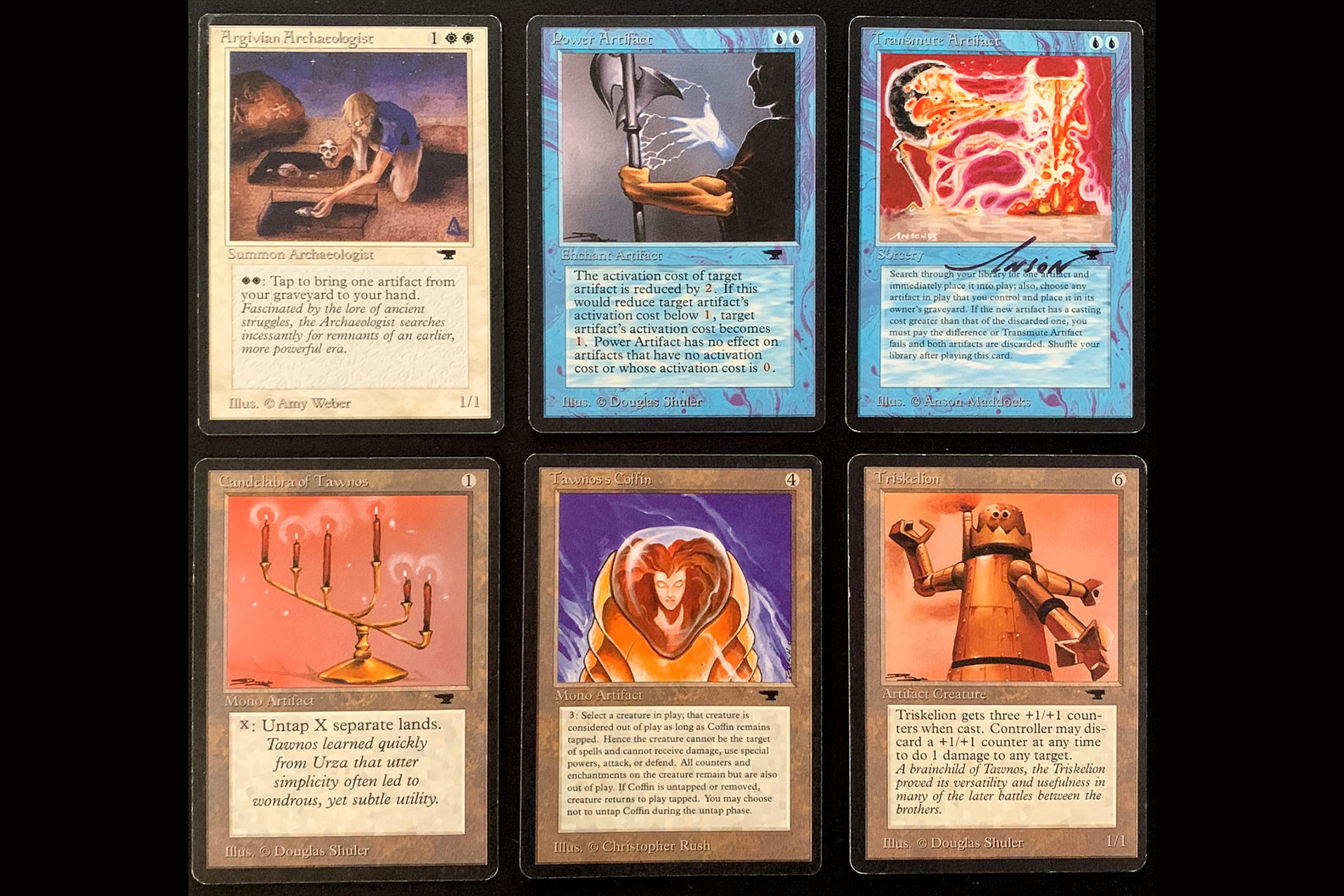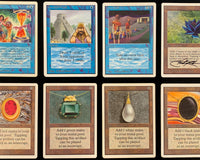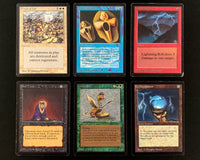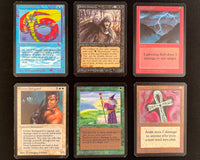Antiquities
We've now already taking a look at Alpha, Beta and Unlimited as well as the first real expansion: Arabian Nights.
Now we are continuing our journey with one of the most epic conflicts Magic: The Gathering has to offer: The Brother's War between Urza and Mishra!
This is of course not to be confused with the release of The Brother's War in 2023, which "only" revisited the famous story between the two brothers.
Antiquities was heavily focused on artifacts. So much so that every card (except for the lands) either were artifacts or referenced artifacts in their text. The lands in Antiquities all produced colorless mana, which was of course another nod towards the artifact theme.
We'll aim to answer a few very important questions:
- Why are Antiquities cards so valuable?
- What are the most expensive cards?
- What misprints to look out for?
- Where to buy Antiquities cards?
Set Information: Antiquities
Antiquities was released on March 4th, 1994. It's the first set that released in 1994 and did so about 3 months after Arabian Nights. Just like Arabian Nights, Antiquities didn't feature any Basic Lands (this time for real) and the set was only 85 cards big.
Antiquities Set Size
The size of the Antiquities expansion officially is 85 cards, but that's not the entire thruth! Depending on the collectors you'd ask, Antiquities actually consists of 100 different cards to collect.
The reason for that are the lands, except for Mishra's Workshop. All other lands in Antiquities got at least two different printings at different rarities!
Urza's Mine, Urza's Power Plant, Urza's Tower, Mishra's Factory and Strip Mine all got four different copies with different art styles.
The different Mishra's Factories are commonly known as Spring Edition, Summer Edition, Autumn Edition and Winter Edition. The reason for that is that they simply depict the Factory in different seasons of the year.
The Rarity Distribution of Antiquities
The rarity distribution of Antiquities was as follows:
28 Commons, 37 Uncommons, 20 Rares
Lucky enough, Antiquities got Rares unlike Arabian Nights! This didn't change much when it came to the actual rarity distribution, though. Rares simply got printed on the Uncommon sheet, at a scarcer rate.
The distribution was organized the same as in Arabian Nights: Sections of UX (X times on the Uncommon sheet) and CX (meaning X times on the Common sheet).
U2 62.000
U3 93.000
C1 93.000
C2 186.000
C4 372.000
What's the Print Run of Antiquities?
The print run of Antiquities was triple that of Arabian Nights: 15 million cards were printed in Antiquities, which means the set was roughly six times the size of the Limited Edition Alpha print run.
The boosters consisted of the same amount of cards as in Arabian Nights: Only 8 cards, with 6 Commons and 2 Uncommons. A booster box contained a total of 60 booster packs.
Fun side note: The booster packs were not entirely random! Due to this, players who wanted to collect all 100 cards had a hard time and WotC introduced a Buy-Back program, where players could send in 100 copies of their duplicates for cash (Source).
Most Expensive Cards: Antiquities
Here are the most expensive cards of Antiquities

(Mishra's Workshop - Currently for sale)
The most expensive card of Antiquities is by far Mishra's Workshop. Getting 3 coloress mana to cast artifacts is literally no drawback if you are playing a lot of artifacts anyhow, which is why this card gets played in playsets in Vintage.
A Mishra's Workshop will cost you between 1600 and 2500 Euros, depending on its condition! The current price trend on Cardmarket is €2128.39 (21.02.2025).

(Candelabra of Tawnos, currently for sale)
The second most expensive card from Antiquities is also a character in The Beauty and the Beast! Jokes aside, the Candelabra of Tawnos is (and probably will stay) a very expensive Magic card. It mostly gets played in Legacy High Tide and 12-Post decks!
A Near Mint Candelabra of Tawnos can be worth between 500 and 950 Euros. The current price trend on Cardmarket is €708.50 (21.02.2025).

(Transmute Artifact, currently for sale)
Now there's a huge drop! The third most expensive card in Antiquities is only roughly worth half of what a Candelabra of Tawnos can be worth. That's still a lot of money, but it also shows how much more valuable the cards in Arabian Nights are in comparison.
The next expensive card in our list is Transmute Artifact. The card actually gets played most in Oldschool (Robots and Artifact Control), but also sees some play in cEDH! Those two formats are enough to drive the price of this unique card.
A Near Mint Transmute Artifact will cost you between 280 and 350 Euros. The current price trend on Cardmarket is €310.62 (21.02.2025).

(Mishra's Factory - Winter Edition, currently for sale)
The Winter Edition of Mishra's Factory is therefore also the most expensive one. This doesn't mean that the Winter Edition Factory is rarer than the others (except for the Spring Edition, which is more common than the other three).
A Near Mint Mishra's Factory (Version 4) can be worth between 170 and 400 Euros. The current price trend on Cardmarket is €283.29 (21.02.2025).

(Power Artifact, currently for sale)
Another blue card barely made the list: Power Artifact! This is again played mostly in cEDH (for example Urza, Lord High Artificer decks) and, of course, Oldschool. In both formats, Power Artifact can go infinite with Basalt Monolith and Grim Monolith (for cEDH) or similar mana rocks.
A Near Mint Power Artifact will cost you between 120 and 180 Euros. The current price trend on Cardmarket is €146.37 (21.02.2025).
Other Expensive Antiquities Cards

(Source: Cardmarket 26.03.2024)
There are still 22 cards that a worth more than 15 Euros and roughly 12 cards that are worth 50 or more Euros. Keep in mind, that these are the cheapest available copies.
A Poor Strip Mine (V.2) might be worth only €17, but a Near Mint Strip Mine (V.2) goes for at least €100!

(Source: Cardmarket 26.03.2024)
Popular Antiquities Misprints
One of the most famous misprints from Arabian Nights, apart from the very popular light/dark differences on mana symbols we discussed earlier, there's at least one other returning error:
Reconstruction Misprint
One of the most famous misprints in Antiquities is on (or rather missing on) a card called Reconstruction. For anyone not familiar with this, the card might look like it was printed in Beta. That's because the set symbol is entirely missing from Reconstruction!

Tawnos's Weaponry Misprint
The second most famous misprint in Antiquities is on 50% of Tawnos's Weaponry. There's actually two version of this card, but for some reason, Cardmarket doesn't differentiate between the two.
On half of the cards named Tawnos's Weaponry, the gray circle behind the activation cost is missing! This little misprint doesn't affect the price or rarity of the card, but it's still a fine little detail for collectors.
Another fun little fact about Tawnos's Weaponry (as well as Ashnod's Battlegear) inspired the Equipment card type as we know it today!
Where to Buy Antiquities Cards?
You want to collect all the 85 (or 100) cards from Antiquities? Start by going through our very own webshop and see if there are any cards you want. Here you can find all our rarest Antiquities cards, like Candelabra of Tawnos or Mishra's Workshop!
Next up, you will want to fill the blanks with all the cheaper Antiquities cards. You can find those cheaper cards on our Cardmarket page.
The next thing you need to do when looking for Antiquities cards is:
Subscribe to our New Arrivals Drop
Every Wednesday, each week of the year, we get new High-End cards. That includes new Antiquities cards, and you'll be the first one to know when the cards you are looking for are available!






